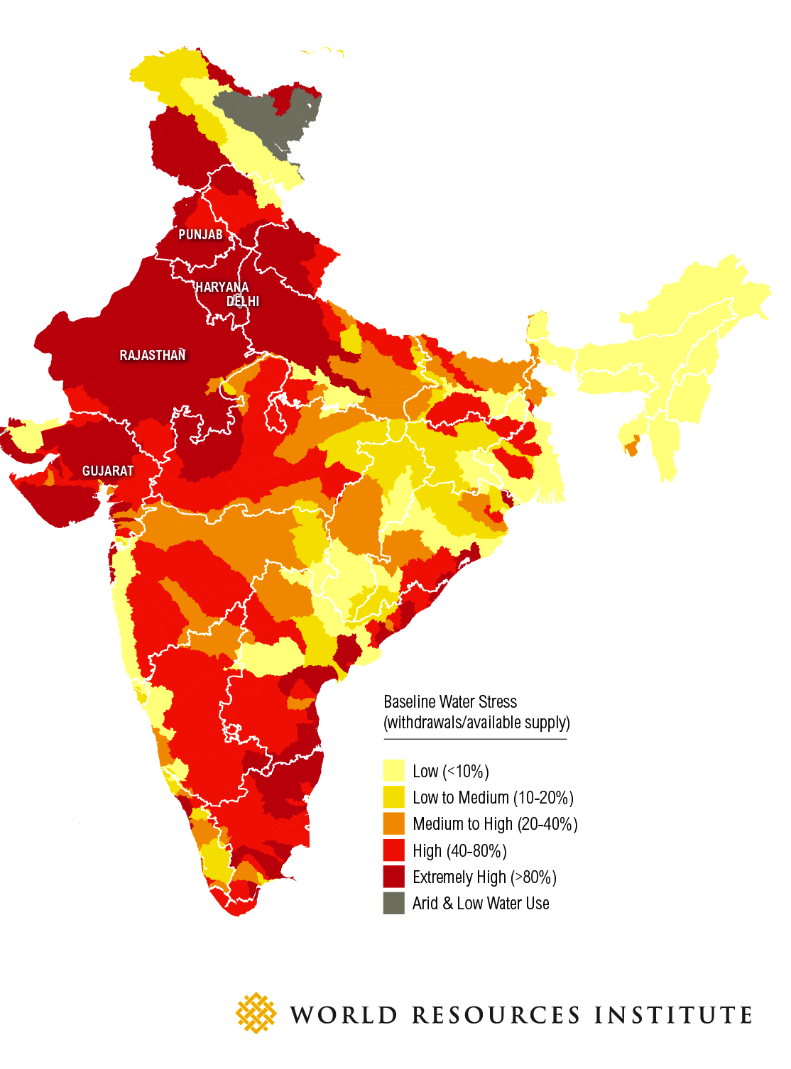Water Stress in India & One Water Approach to Water Management
2022 SEP 20
Mains >
Geography > Resource geography > water management
IN NEWS:
- The United Nations has estimated that by the year 2050, four billion people will be seriously affected by water shortages.
- Therefore, shifting attention from a single-minded and linear water management to a multi-dimensional integrated water management approach, that is, the ‘One Water’ approach, is required for the resilient and sustainable management of water resources.
- India, which is facing acute water stress, can implement the ‘One Water’ approach for sustainable management of water resources.
WATER STRESS AND WATER SCARCITY:
- Annual per-capita water availability of less than 1700 cubic meters is considered as water stressed condition
- Annual per-capita water availability below 1000 cubic meters is considered as a water scarcity condition.
WATER STRESS IN INDIA:
- India has 4% of world’s water resources but supporting 16% of world’s population
- According to the World Resources Institute, 54% of the total area in India is facing water stress.
- A report titled “Composite Water Management Index (CWMI)”, published by NITI Aayog in June 2018, mentioned that India was undergoing the worst water crisis in its history; that nearly 600 million people were facing high to extreme water stress.
- The report further mentioned that India was placed at the rank of 120?amongst 122 countries in the water quality index, with nearly 70 per cent of water being contaminated.
- It projected the country’s water demand to be twice the available supply by 2030, implying severe scarcity for hundreds of millions of people and an eventual loss in the country’s GDP.
------------------------------------
REASONS FOR THE WATER CRISIS:
- Social:
- Increased demand for water for domestic, industrial and agricultural needs and limited surface water resources lead to the over-exploitation of groundwater resources.
- Economic:
- Increasing Per capita income led to increased consumption of sugar, fruits, vegetables ,milk, eggs etc which led to increased water demand.
- Intensive irrigation for agriculture through canals, tanks and wells or tubewells especially in green revolution regions like Punjab, West UP and Haryana.
- Water intensive industrial growth
- Dependence on thermal power generation (86% according to CEA ) which is highly water intensive.
- Inefficiency in water distribution and management e.g. open canals.
- Infrastructural gaps in water conservation.
- Ecological:
- Water Pollution from agriculture, industries and households leading to eutrophication.
- Decline in groundwater table leads to increased concentration of arsenic and fluoride.
- Saline water intrusion lowers the quality of freshwater sources
- Deforestation decreasing water holding capacity of soil
- Geographic:
- Crystalline rocks decrease percolation and groundwater recharge.
- Difference in rainfall distribution creates droughts in regions e.g. Rajasthan
- Drier regions becoming more drier due to climate change.
- Political:
- Interstate water disputes hampers efficient utilisation of water e.g. Cauvery dispute
- Comprehensive water framework law is absent in India.
- Policy focus on surface irrigation led to neglect of ground water exploitation.
- Unrealistic pricing of water led to wastage of water.
- Privatisation of tankers led to more ground water extraction.
WHAT IS ‘ONE WATER’ APPROACH?
- ‘One Water’ approach, also referred as Integrated Water Resources management (IWRM), is an integrated planning and implementation approach to managing finite water resources for long-term resilience and reliability meeting both community and ecosystem needs.
- ‘One Water’ is the recognition that all water has value, regardless of its source.
- It includes managing that source in an integrated, inclusive and sustainable manner by including the community, business leaders, industries, farmers, conservationists, policymakers, academics and others for ecological and economic benefits.
------------------------------------
CHARACTERISTICS OF ‘ONE WATER’ APPROACH:
- Recognize that all water has value:
- The mindset that all water has value, from the water resources in our ecosystems to our drinking water, wastewater and stormwater.
- Multi-faceted approach:
- Water-related investments should provide economic, environmental, and societal returns.
- Watershed-scale thinking and action:
- Utilising watershed-scale thinking and action that respects and responds to the natural ecosystem, geology, and hydrology of an area.
- Partnerships and inclusion of all stakeholders:
- Partnerships and inclusion in recognising that real progress and achievements will only be made when all stakeholders come forward and together will take a decision.
OBJECTIVES OF ‘ONE WATER’ APPROACH:
- Reliable, secure, clean water supplies
- Aquifer recharge
- Flood protection
- Minimising environmental pollution
- Efficient use and reuse of natural resources
- Resiliency to climate
- Long-term sustainability
- Equity, affordability and access
‘ONE WATER’ APPROACH V/S CONVENTIONAL WATER MANAGEMENT APPROACHES:
- In the conventional water management approach, drinking water, wastewater and stormwater are managed separately, whereas in ‘One Water’, all the water systems, regardless of its source, are connected intentionally and managed meticulously for water, energy and resource.
- Water is recycled and reused several times in IWRM, in contrast to a one-way route from supply to use, treatment and disposal.
- Stormwater is utilised as a valuable resource to fight against water scarcity, recharge groundwater and support natural vegetation.
- The water system includes green infrastructures and a mix of grey and green infrastructure that form a hybrid system as compared to grey infrastructure in conventional water management.
- The interconnectedness of surface water, groundwater, stormwater and wastewater is collectively recognised and managed by these separate but connected entities.
- Active collaborations with industry, agencies, policymakers, business leaders and various stakeholders is a regular practice in the ‘One Water’ approach, whereas collaboration is need-based in conventional water management systems
CONCLUSION:
- Aged infrastructure, supply-centric management, polluted waterbodies, agricultural and industrial expansion following changes in consumption and production patterns, a changing climate, and inefficient utilisation of the water resources which cause acute water stress in India can be rectified by adopting ‘One Water’ approach.
PRACTICE QUESTION:
Q.“Inefficient utilisation of the water resources which cause acute water stress in India can be rectified by adopting ‘One Water’ approach”. Discuss.

